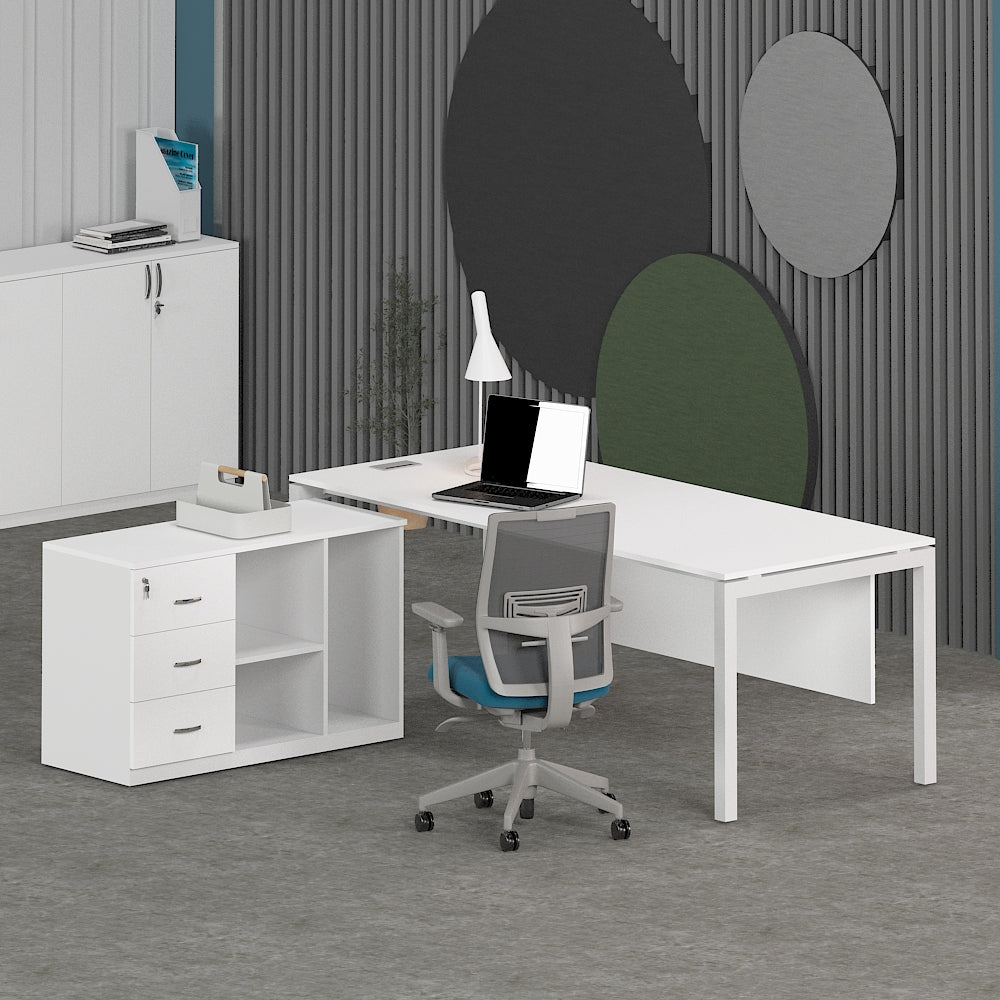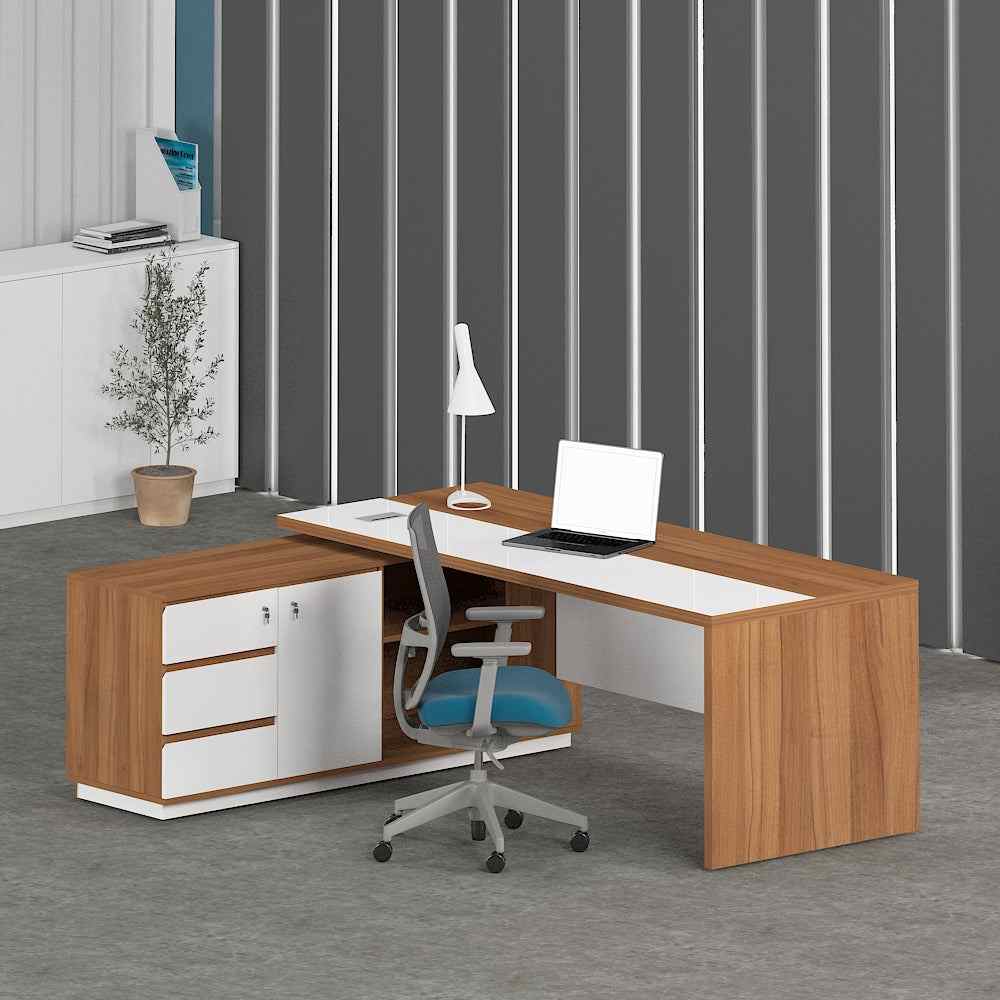Selecting the appropriate size for an managerial office table can significantly impact both the efficiency and aesthetics of your work environment. An office leadership table is not just a item of furniture; it is a central element that shapes your office environment. Regardless of whether executive desk office suite designing a modern office or a traditional workspace, grasping the various sizes and configurations available will help you establish an efficient and attractive atmosphere.
When evaluating the perfect size for your leadership table, there are a number of factors to keep in mind. The measurements of the table should meet your needs without filling the space. Additionally, the design of the table, whether an L shape, wooden finish, or even a glass top, will also have a critical role in its overall fit within your office design. Price points can vary widely based on size, materials, and brand, such as Godrej or other manufacturers. By assessing these factors, you can ensure that your managerial office table not only fulfills your practical requirements but also supports your business image.
Comprehending Leadership Desk Dimensions
Selecting the suitable size for an management workspace table is vital for creating an efficient workspace. The optimal size are determined by various factors like the size of the workspace, the layout, and the number of people who will be employing the table. A big executive table may give a imposing appearance in a large office but can dominate smaller spaces, making it important to balance aesthetics with functionality.
Standard sizes for executive tables usually range from 60 to 72 inches in span, with thicknesses differing between 30 to 36 inches. This facilitates easy use while additionally providing ample workspace for documents, computers, and personal items. For workspaces utilizing an L-shaped layout, the dimensions can change significantly, as these desks typically broaden the usable area and can more easily accommodate multiple users or collaborative work.
Furthermore, when evaluating the dimensions, it's also necessary to factor in the related pieces, such as seating and shelving units. Ensuring there is ample room to navigate the desk without being congested is critical for productivity and comfort. Therefore, a careful consideration of the executive table’s sizes in relation to the whole workspace space is crucial for achieving an ideal workplace setting.
Design Considerations for Executive Tables
As you selecting a executive office table, the design is a key factor that influences workspace functionality and aesthetics. Think about the layout of your office and how the table will fit within that space. An L-shaped executive table can function well in corners, maximizing the area while offering ample surface for work and meetings. Moreover, look for designs that incorporate storage solutions such as cabinets or shelves, as these can help ensure a clutter-free environment, enhancing productivity.

Choosing materials is also an important design consideration. Office executive tables are available in multiple materials including wood, glass, and metal. Wooden tables offer a classic, professional appearance while providing durability, making them suitable for a traditional office setting. Conversely, a glass top can add a modern touch and create an illusion of a more spacious environment. It's vital to choose a material that matches with the overall office decor and the image you want to project.
The ergonomic aspect should be considered in the design process. The height and size of the executive table should accommodate the user well to support good posture during long working hours. Additionally, consider the compatibility with executive chairs, making sure that both elements work harmoniously together. Considerate design can significantly impact not just the look of the office but also the well-being and efficiency of its employees.
Planning for Your Corporate Office Table
When selecting an managerial table, cost estimation should be a primary consideration. Prices can differ considerably based on materials, style, and attributes. Wood tables often offer sturdiness and a classic look, but they may carry a more substantial price tag. On the contrary hand, tables with glass tops can add a contemporary touch and may be more budget-friendly, according to the design and details. Explore various choices to find a style that suits your taste and financial plan.
It is important to consider not just the upfront cost of the table, but also additional expenses that may arise. For example’s sake, if you opt for a table that needs an accompanying chair set, be sure to incorporate that into your budget. Additionally, other accessories such as filing cabinets or additional workspace might be needed, affecting your overall cost. Assessing the total cost helps in making a more informed decision.
Lastly, search for options from various retailers to find competitive pricing. Brands like Godrej offer diverse executive office table designs at various price points, which can offer a decent balance between durability and value. Take benefit from discount sales or discounts that may be on offer, which can aid stretch your budget even more. Focusing on your needs and considering multiple cost packages will guarantee you discover the right executive office table without surpassing your financial limits.
Popular Designs and Materials
When picking an executive office table, design plays a crucial role in conveying the ideal image for your workspace. Well-liked styles include traditional, contemporary, and innovative designs. Traditional tables often include rich wood finishes with intricate detailing, making them suitable for business-like environments. In contrast, modern styles typically adopt clean lines and minimalistic designs, often featuring metal and glass elements. Contemporary executive office tables frequently use innovative shapes and materials, providing a sleek appearance that can energize the office atmosphere.

Materials are just as important when choosing an executive office table. Wood remains a traditional choice, offering durability and a pleasant aesthetic that can complement various office designs. Choices such as beech, mahogany, and pine are common, each providing different levels of robustness and aesthetic appeal. Glass tops paired with steel frames are increasing popularity, as they convey a sense of openness and can make smaller offices appear expanded. Additionally, composite materials and laminates offer cost-effective solutions without sacrificing aesthetic.
Finally, the choice of accessories and finishes can enhance the overall look and functionality of your executive office table. Choices like built-in cable management, integrated storage solutions, and coordinated office chairs can create a harmonious and efficient workspace. Choosing the best combination of style, materials, and accessories ensures that your executive office table not only fulfills your functional needs but also corresponds with the desired ambiance of your office environment.

